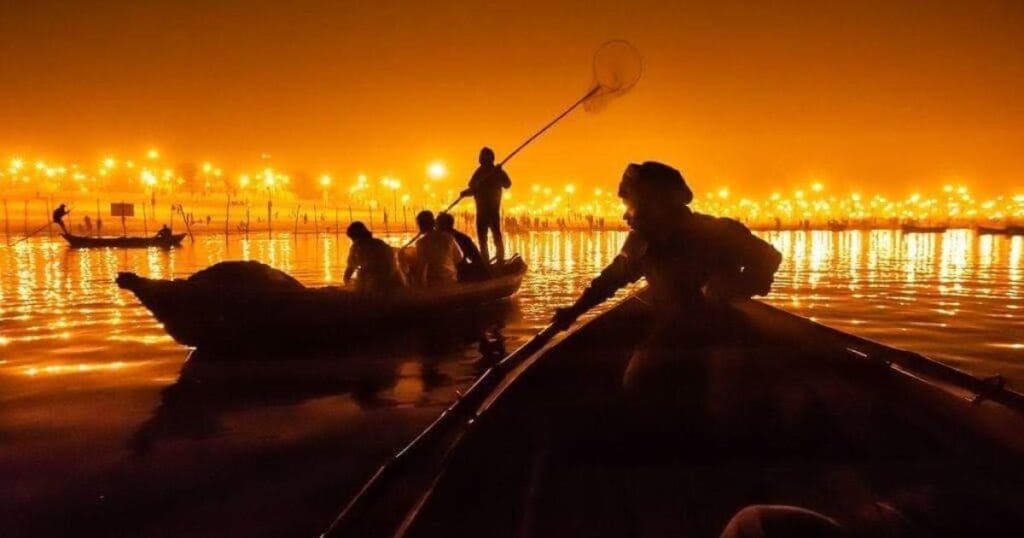Best Temples in Varanasi , Discover the best Varanasi Temple Guide with this spiritual guide. Explore sacred sites like Kashi Vishwanath and Sankat Mochan for an unforgettable journey Spiritual Guide Varanasi .
Nestled along the banks of the sacred Ganges River, Varanasi is considered one of the holiest cities in India and a vital destination for spiritual seekers. With its deep-rooted history, the city is home to hundreds of temples, each carrying centuries of tradition and cultural heritage. This guide explores the best temples in Varanasi, giving you insight into their religious significance, historical background, and architectural beauty.

- Kashi Vishwanath Temple: The Holiest of All
- Sankat Mochan Hanuman Temple: The Protector of Devotees
- Durga Temple (Durga Kund Mandir): The Power of Shakti
- Annapurna Devi Mandir: The Goddess of Nourishment
- Kal Bhairav Temple: The Guardian of Kashi
- Mrityunjay Mahadev Temple: The Lord of Life and Death
- New Vishwanath Temple (Birla Temple): A Modern Marvel
- Tulsi Manas Mandir: The Birthplace of Ramcharitmanas
- Bharat Mata Temple: A Unique Patriotic Shrine
- Quick Tips for Visiting Temples in Varanasi
Kashi Vishwanath Temple: The Holiest of All
Kashi Vishwanath Temple, dedicated to Lord Shiva, is perhaps the most revered temple in Varanasi and among the most significant in Hinduism. Known as the “Golden Temple” due to its gilded spires, Kashi Vishwanath has been a center of spiritual energy for thousands of years. It is believed that one visit here grants liberation from the cycle of rebirth & Best Temples in Varanasi .
Highlights:
- Golden Spires: Stunning golden domes donated by Maharaja Ranjit Singh of Punjab.
- Jyotirlinga: Houses one of the twelve Jyotirlingas, which are sacred shrines dedicated to Lord Shiva.
- Spiritual Significance: It’s said that those who die in Kashi attain moksha (liberation).
Sankat Mochan Hanuman Temple: The Protector of Devotees
Another must-visit is the Sankat Mochan Hanuman Temple, dedicated to Lord Hanuman, the deity known for his strength and protection. Believed to relieve devotees from obstacles and hardships, this temple is an essential part of Varanasi’s spiritual fabric.
Highlights:
- Devotional Thursdays and Tuesdays: These are the days of worship, drawing large crowds of devotees.
- Prasad (Offering): The famous Besan Laddoo is distributed as a divine offering to devotees.
- Special Festivities: The annual Hanuman Jayanti festival draws pilgrims from across India for the temple’s grand celebrations.
Durga Temple (Durga Kund Mandir): The Power of Shakti
The Durga Temple, also known as Durga Kund Mandir, is dedicated to Goddess Durga, representing feminine power. Built in the 18th century by a Bengali queen, the temple is an architectural marvel featuring a red ochre exterior symbolizing strength and valor.
Highlights:
- Historical Architecture: The temple’s structure reflects the Nagara style of architecture.
- Durga Kund: A rectangular water tank next to the temple, where devotees perform rituals.
- Navaratri Festival: Durga Temple becomes a hub of spiritual activities during Navaratri, drawing thousands of visitors.
Annapurna Devi Mandir: The Goddess of Nourishment
Located close to Kashi Vishwanath Temple, Annapurna Devi Mandir is dedicated to Goddess Annapurna, who is believed to be the giver of food and prosperity. Devotees visit this temple to seek blessings for abundance and fulfillment.
Highlights:
- Idol of Annapurna: A rare and unique statue of the goddess holding a bowl symbolizing nourishment.
- Annadan (Food Donation): Food offerings are regularly distributed, symbolizing the goddess’s grace.
- Dhanteras Celebrations: The temple is beautifully decorated, and special prayers are offered during the festival of Dhanteras.
Kal Bhairav Temple: The Guardian of Kashi
Kal Bhairav, also known as the “Kotwal of Kashi” (Guardian of Varanasi), is a fearsome form of Lord Shiva worshiped here. Legend says that those who visit Kashi without seeking his blessings may not have a complete pilgrimage.
Highlights:
- Iconic Image of Bhairav: The deity here holds a trident and is adorned with garlands of flowers.
- Protective Amulets: Devotees buy protective amulets (Kavach) from the temple as a blessing.
- Temple Rituals: Special prayers on Tuesdays and Sundays are a major attraction, offering devotees a sense of security and protection.
Mrityunjay Mahadev Temple: The Lord of Life and Death
Located on the busy Varanasi streets, the Mrityunjay Mahadev Temple is known for its powers to protect against untimely death and diseases. Devotees believe that offering prayers here brings blessings of good health and longevity.
Highlights:
- Healing Powers: The temple is famous for its powerful chants and hymns, particularly the Mahamrityunjay Mantra.
- Unique Shivlinga: The Shivlinga is said to possess medicinal properties, and devotees often pour water over it as a ritual.
- Spiritual Energy: Visitors to this temple often report a feeling of deep tranquility and positive energy.
New Vishwanath Temple (Birla Temple): A Modern Marvel
Located within the campus of Banaras Hindu University (BHU), the New Vishwanath Temple is a relatively recent addition to Varanasi’s temple landscape. It was built by the Birla family, one of India’s most prominent business dynasties, as a dedication to Lord Shiva.
Highlights:
- Sprawling Campus: Built on a large scale with tall spires, the temple offers a peaceful ambiance away from the city’s bustling streets.
- Replica of Kashi Vishwanath Temple: The New Vishwanath Temple was modeled after the original, making it an architectural marvel.
- BHU Connection: Being located within BHU, it draws a mix of students, devotees, and tourists, adding a youthful energy to the space.
Tulsi Manas Mandir: The Birthplace of Ramcharitmanas
Dedicated to Lord Rama, the Tulsi Manas Mandir holds significant historical and literary importance. It’s believed that this is where poet-saint Tulsidas wrote the Ramcharitmanas, a retelling of the Ramayana in the local dialect of Awadhi.
Highlights:
- Engraved Verses: The walls of the temple are inscribed with verses from the Ramcharitmanas.
- Serene Atmosphere: Away from the crowd, the temple offers a quiet place for meditation and reflection.
- Cultural Significance: The temple is a tribute to the impact of Tulsidas on Indian literature and spirituality.
Bharat Mata Temple: A Unique Patriotic Shrine
The Bharat Mata Temple is a rare temple in India that’s dedicated not to a deity, but to Mother India. Built by freedom fighter Babu Shiv Prasad Gupta, the temple features a large relief map of India carved out of marble, symbolizing unity and reverence for the nation.
Highlights:
- Marble Relief Map: A unique 3D map of India showcasing mountains, rivers, and geographical features.
- Patriotic Vibe: The temple celebrates India’s diversity and spirit, making it popular among tourists and locals.
- Non-Religious Shrine: It’s a symbol of Indian pride, dedicated to the nation rather than any religious figure.
Quick Tips for Visiting Temples in Varanasi
- Dress Modestly: Traditional attire like saris or kurtas are ideal. Shorts or sleeveless tops are often discouraged.
- Check Temple Timings: Many temples have specific hours, with early mornings and late evenings being the busiest.
- Respect Rituals: Be mindful of ongoing rituals, and seek permission if you wish to photograph any part of the temple.
- Stay Hydrated: Carry water, especially during summer visits, as temple complexes can be large and crowded.
Each of these temples represents a unique aspect of Varanasi’s spiritual and cultural identity, allowing you to connect with the city’s sacred traditions. From the mystical aura of Kashi Vishwanath to the peaceful vibes of Bharat Mata Temple, Varanasi’s temples offer an unforgettable journey into India’s religious heart.






